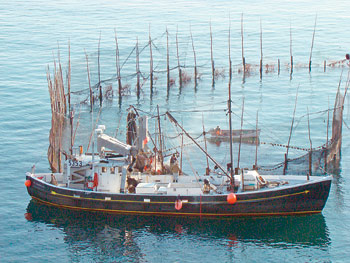Herring Fishermen Seek Flexibility
by Laurie Schreiber
|
Only a dozen or so people turned out to make a statement on new proposed actions for the interstate herring fishery.
But the turnout was better than hearings elsewhere in Maine. Rockland’s was poorly attended, and no one showed up for Portland’s.
“Nobody cares,” one Ellsworth man commented.
Fishermen were asked to comment on options aimed at spreading out the annual fishing quota to ensure a steady supply of fish through the year.
The Atlantic States Marine Fisheries Commission’s (ASMFC) Atlantic Herring Section last October decided to initiate Addendum I to Amendment 2 to the Interstate Fishery Management Plan for Atlantic Herring to include monthly or bimonthly quotas with payback and carry over, determination of landing and fishing days, no fishing prior to June 1, timely reporting of state registered landings, and restrictions on the harvest of juvenile fish.
Most Maine herring fishermen fish in management Area 1A (Gulf of Maine), which receives the greatest amount of fishing pressure. Fishermen there routinely harvest the entire total allowable catch. Area 1A is close to shore, making it easily accessible to fishermen, and schools of herring are easily located once they migrate inshore.
continue
|

The fixed gear fishery, weirs and stop seines, would be exempt from herring effort control mechanisms being proposed. Man O’War weir seen from top of White Rock cliff. The Mauvis (carrier out of Head Harbour, Campobello Island) is owned by Sonny Flynn. Photo by Chessie Johnson |
|
Historic Maine, A Treasure Hunter's Paradise
by Tom Seymour
|
Maine’s history dates back thousands of years, beginning with the so-called, “Red Paint People,” indigenous humans who buried their dead with varying amounts of red ocher, or powdered hematite. Norsemen sailed the New England coastline beginning around 1,000 and some evidence suggests that they visited Maine. Then, in 1497, John, Lewis, Sebastian and Sancius Cabot, sailed along Maine’s coast, on a directive from English King Henry VII. From that point on, the wave of Europeans continued and today, our state holds at least vestigial traces of the countless people and groups who either visited Maine or planted roots here and became part of Maine society and eventually, Maine history.
continue
|
| For many centuries Mt. Kineo in Moosehead Lake was the source of high grade flint. American Indians used it, traded it, and transported it around northern New England. Tom Seymour photo |
|
|

